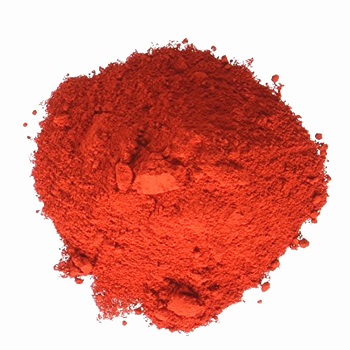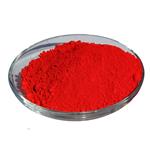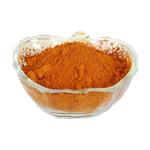Lead oxide is a general term and can be either lead monoxide or "litharge" (PbO); lead tetroxide or "red lead" (Pb3O4); or black or "gray" oxide which is a mixture of 70 percent lead monoxide and 30 percent metallic lead. Black lead is made for specific use in the manufacture of lead acid storage batteries. Because of the size of the lead acid battery industry, lead monoxide is the most important commercial compound of lead, based on volume.

Red lead is produced by oxidizing litharge in a reverberatory furnace.
The major lead pigment is red lead(Pb3O4), which is used principally in ferrous metal protective paints.
Bright-red crystalline substance or amorphous powder; density 9.1 g/cm3; decomposes on heating to 500°C, melts at 830°C under pressure and oxygen; insoluble in water and alcohol; soluble in glacial acetic acid, hot hydrochloric acid, and a dilute nitric acid-hydrogen peroxide mixture.
Lead tetroxide has many applications. The most important use is in paint and storage-batteries. It is used as a pigment in corrosion-protecting paints for steel surfaces. It also is used in positive battery plates; in colored glasses and ceramics; in glass sealants for television picture tubes; in propellants and explosives; in radiation shields for x-rays and gamma rays; in the vulcanization of rubber; in glass-writing pencils; in adhesives for tire cords; in foaming agents and waterproofing materials; in plasters and ointments; in lead dioxide matches; and as a catalyst for oxidation of carbon monoxide in exhausts.
Lead tetroxide is made by heating lead monoxide in the presence of air at temperatures between 450 to 500°C. The temperature should be maintained below 500°C, above which the tetroxide decomposes.
6PbO + O2→2Pb3O4
Alternatively, the tetroxide may be prepared by heating a mixture of lead monoxide and lead dioxide at 250°C:
2PbO + PbO2→Pb3O4
When heated above 550°C, the tetroxide decomposes to monoxide, evolving oxygen:
6Pb3O4→6PbO + O2
Lead tetroxide reacts with dilute nitric acid forming lead nitrate and precipitating lead dioxide:
Pb3O4 + 4HNO3 → 2Pb(NO3)2 + PbO2 + 2H2O
The above reaction may be explained by assuming lead tetroxide as formally equivalent to plumbus plumbate having a structure Pb2II[PbIVO4] in which Pb2+ dissolves in dilute nitric acid forming lead(II) nitrate while Pb4+ precipitates out as lead(IV) oxide.
Lead tetroxide reacts with anhydrous acetic acid at 80°C producing lead(II) acetate and lead(IV) acetate. Alternatively, the tetroxide is added into a mixture of glacial acetic acid and acetic anhydride and heated gently:
Pb3O4 + 8CH3COOH → 2Pb(CH3COO)2 + Pb(CH3Coo)4 + 4H2O
On cooling, the tetraacetate crystallizes, leaving diacetate in the solution. Acetic anhydride is added to react with water produced in the reaction to form acetic acid and thus prevent hydrolysis.
Lead tetroxide can be reduced to metallic lead when heated with reducing agents, such as hydrogen, carbon, or carbon monoxide:
Pb3O4 + 4H2→3Pb + 4H2O
Lead oxide, a range of products that is formed by the oxidation of Lead in the forms of liquid and solid. Lead oxides are basically an oxide’s family varying in color (grey/green, red, and yellow), in degree of oxidation (PbO, Pb3O4, PbO2) and in crystal structure (in forms of PbO, orthogonal and tetragonal).
Lead oxide is a term that can be either Lead monoxide or litharge Lead tetroxide or Red Lead or Gray or Black oxide which is a mixture of 30 percent metallic Lead and 70 percent Lead monoxide. Black Lead is made for specific use in Lead acid storage batteries manufacturing. Due to large use in the Lead acid battery industry, Lead monoxide is one of the most important compounds of Lead, based on volume. Due to its electrical and electronic properties, litharge is also used in various components for different types of use like capacitors, electro photographic plates, and Video tubes, even in ferromagnetic and ferroelectric materials. Their wide range of chemical and physical properties, Lead oxides have been know and used worldwide since before the ancient Romans.
Lead(II,IV) oxide is used to prepare colorless glass, faience glaze, porcelain painting flux, iron and steel coatings, rubber pigment and in glass cement. It is also used in gas and steam pipes, storage batteries, writing on glass and to make lead peroxide and matches. It is associated with linseed oil and used as a thick, long-lasting anti-corrosive paint. It gives better water resistant properties by replacing magnesium oxide. Further, it is used in the manufacture of lead glass and rustproof primer paints. In addition to this, it acts as a pigment for primer paints for iron objects.
Red lead (Pb3O4) is a brilliant red-orange colored synthetic inorganic
pigment used mainly as a protective priming coat for steel work rather
than a coloring pigment in paints. The toxic nature of this pigment
restricts its use in modern coating systems.
Plasters and ointments; manufacture of colorless glass; glaze for faience; flux for porcelain painting, protective paint for iron and steel; oil-color for ship paints, varnishes; coloring rubber; cement for glass, gas and steam pipes; storage batteries; pencils for writing on glass; manufacture of lead peroxide, matches.
Lead(IV) oxide, Pb2O, is obtained by action of chlorine on alkaline solutions of lead(II) oxide or acetate. The reaction is Pb(OH)3-+ ClO- → PbO2 + Cl- + OH- + H2O·PbO2 can also be produced on a lead or platinum anode by electrolysis in acidic solution.
Natural red oxide of lead.
World Health Organization (WHO)
Lead oxides and other lead salts were formerly available in
topical preparations which had soothing astringent properties. The toxicity of lead
salts by inhalation, ingestion and percutaneous absorption is now conclusively
established and the medicinal use of preparations containing lead salts is no
longer permitted in many countries.
Flammability and Explosibility
Not classified
core: lead
reagent type: catalyst
Lead oxide is used quite extensively in optical glass, electrical glass, and tableware. It increases the density and refractive index of glass. In addition, it can be cut more easily than other glasses and has superior brilliance, both of which make it good for cut glass.
Lead glasses may be formulated with a wide variety of electrical and acid-resisting characteristics; desirable properties, such as weather resistance, electrical resistivity, etc., will depend upon the total composition of the glass.




